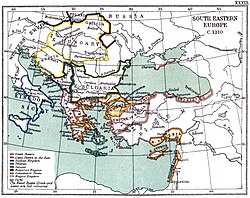Manuel Maurozomes
Manuel Komnenos Maurozomes (
Biography
Little is known of Manuel's early life. The Maurozomai, a family possibly of Peloponnesian origin, rose to prominence in the 12th century and belonged to the aristocracy.[1] Manuel has traditionally been identified as a son of Theodore Maurozomes, who served as a general under Emperor Manuel I Komnenos (r. 1143–1180), and while earlier scholars, following Paul Wittek, made him the husband of an illegitimate daughter of the emperor, more recent scholars follow the reconstruction of Konstantinos Varzos, which makes her Manuel Maurozomes' mother, thus explaining his claim to the prestigious Komnenos name.[2]
Around 1200, when the deposed Seljuk sultan Kaykhusraw I (r. 1192–1196, 1205–1211) came to Constantinople, Maurozomes held, according to the Seljuk chronicler Ibn Bibi, the rank of Caesar in the Byzantine court.[1] During his stay in the Byzantine capital, Kaykhusraw was apparently baptized a Christian with Emperor Alexios III Angelos (r. 1195–1203) as his godfather, and married Manuel's daughter; thus Manuel became the ancestor of the Seljuk sultans Kayqubad I (r. 1220–1237) and Kaykhusraw II (r. 1237–1246).[1][3]

When Alexios III fled Constantinople at the approach of the
With Seljuk backing, Maurozomes tried now to carve out a principality for himself in
Maurozomes remained a Seljuk vassal until his death in c. 1230, and played an important role in the affairs of the Seljuk state: he received the rank of emir, helped secure the accession of his grandson Kayqubad I in 1220, and participated in the Seljuk campaigns against the Armenian Kingdom of Cilicia.[7] Claude Cahen identifies Maurozomes with a certain Emir Komnenos, who appears over the following decades as a Christian supporter of Kaykhusraw and Kayqubad.[8] His descendants remained active in the Seljuk court until the end of the 13th century, although they retained their Christian faith: a John Komnenos Maurozomes (probably Manuel's son), his son Isaac-John and his grandson Michael are attested in Michael's funerary inscription, dating to 1297.[2][1]
References
Sources
- Brand, Charles M. (1989). "The Turkish Element in Byzantium, Eleventh-Twelfth Centuries". Dumbarton Oaks Papers. 43. Dumbarton Oaks, Trustees for Harvard University: 1–25. JSTOR 1291603.
- ISBN 0-19-504652-8.
- Cahen, Claude (2014). Pre-Ottoman Turkey: A General Survey of the Material and Spiritual Culture and History c. 1071-1330. New York: American Council of Learned Societies. ISBN 978-1-59740-456-3.
- Magoulias, Harry J., ed. (1984). O City of Byzantium. Annals of Niketas Choniates. Detroit: Wayne State University Press. ISBN 0-8143-1764-2.
- Varzos, Konstantinos (1984). Η Γενεαλογία των Κομνηνών [The Genealogy of the Komnenoi] (PDF) (in Greek). Vol. A. Thessaloniki: OCLC 834784634.
- Vougiouklaki, Penelope (2003). "Manuel Maurozomes". Encyclopedia of the Hellenic World, Asia Minor. Foundation of the Hellenic World. Retrieved 26 September 2012.
